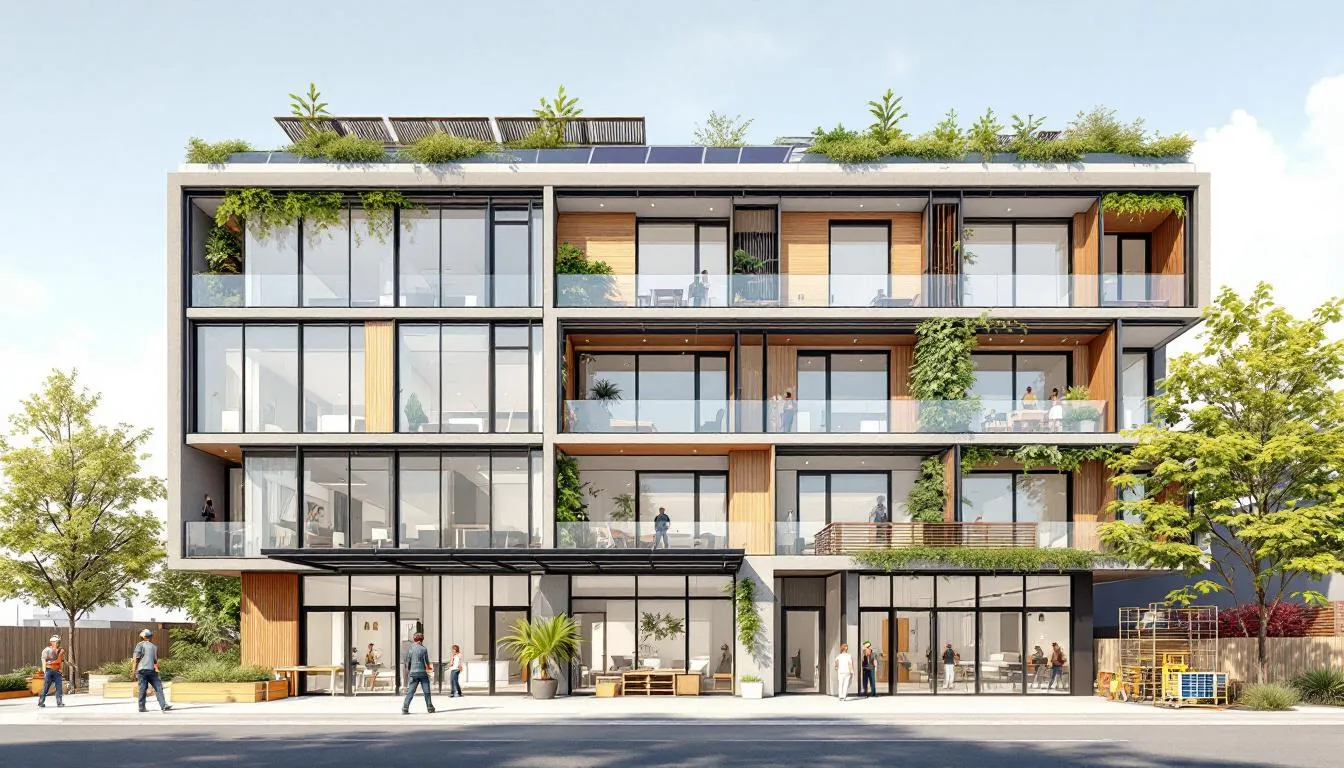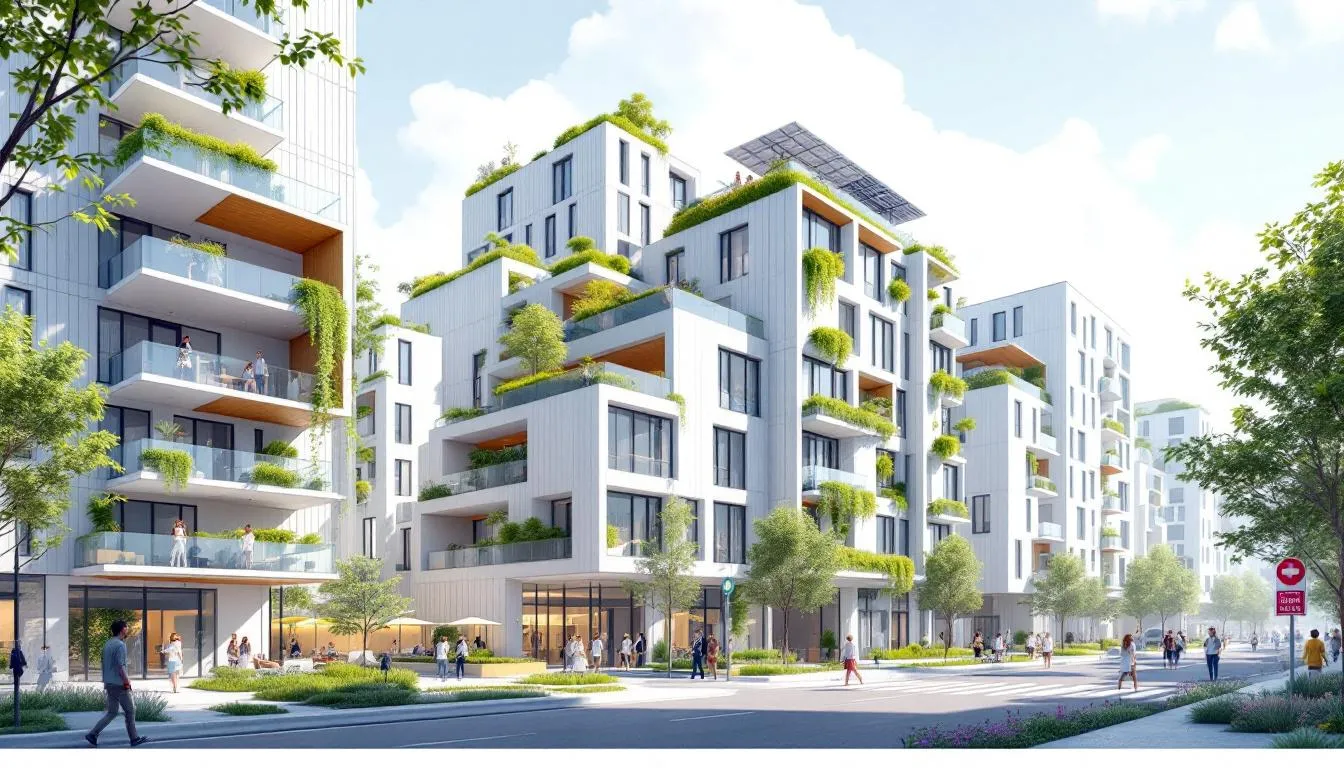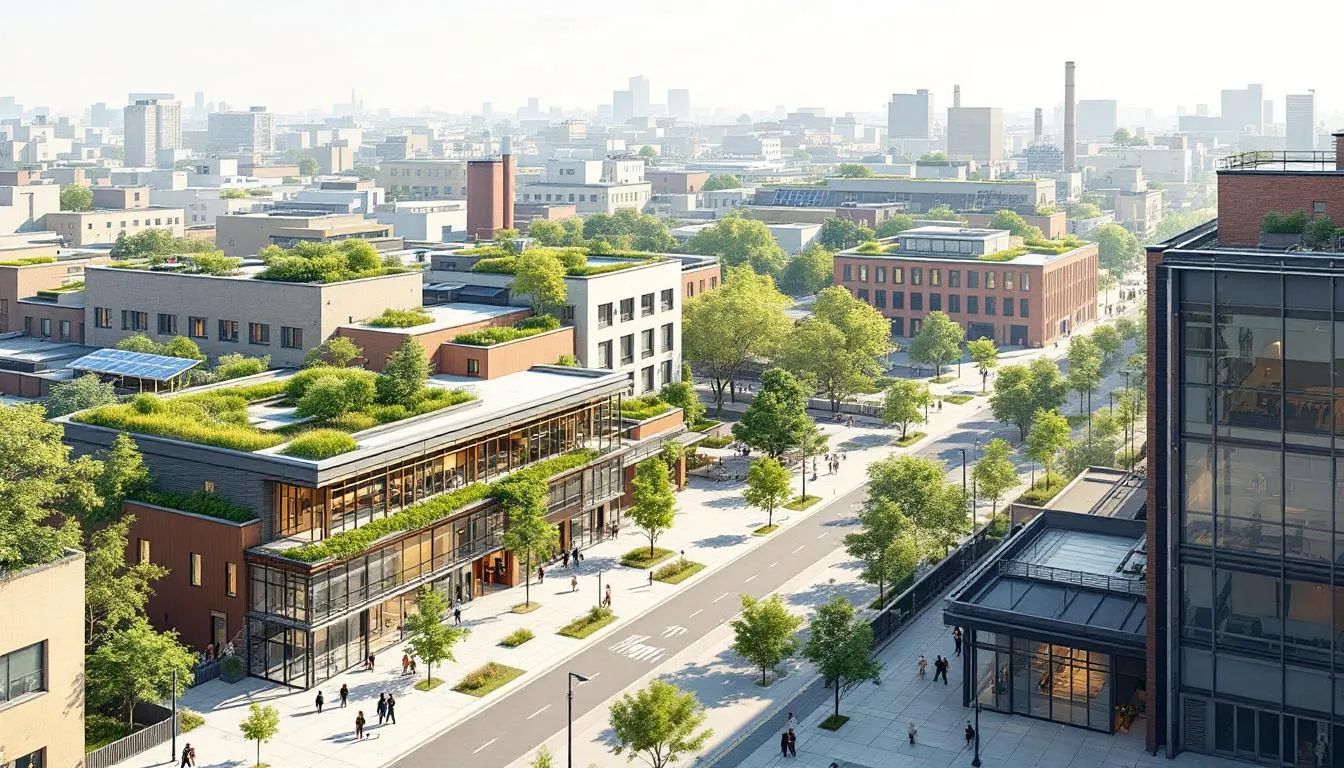Commercial to residential conversion involves transforming commercial buildings like offices or retail spaces into residential units. This trend is growing due to the increased demand for housing and reduced need for commercial spaces. Changes in working patterns due to the COVID-19 pandemic have increased the availability of commercial properties for conversion. In this article, we’ll cover the basics of these conversions, their benefits, legal considerations, challenges, financing methods, and successful examples.
Key Takeaways
- Commercial to residential conversions repurpose vacant commercial spaces to address housing shortages and revitalise urban areas.
- Permitted Development Rights (PDRs) simplify the conversion process by allowing specific use changes without full planning permission, reducing project timelines and costs. However, these rights only cover specific types of changes and are subject to certain limitations and conditions.
- Successful conversions require due diligence, compliance with local regulations, and careful financial assessments to overcome common challenges like planning restrictions and space design.
- Conversions of commercial properties can be more lucrative due to reduced competition compared to new builds.
Understanding the Basics of Commercial to Residential Conversion

Commercial to residential conversion transforms commercial properties into residential units, addressing the growing demand for housing. This practice not only helps alleviate the housing crisis by repurposing vacant commercial spaces into homes but also revitalises urban areas by infusing them with new life and activity.
What is a Commercial to Residential Conversion?
At its core, a commercial to residential conversion involves changing the use of a building from commercial purposes—such as offices, retail spaces, or warehouses—into residential living spaces. This trend is gaining traction due to the rising demand for residential properties and residential change, driven by factors like insufficient home building and increased remote working, particularly in converting commercial buildings and creating conversion opportunities. Local authorities are increasingly promoting developments within towns to utilise existing commercial structures.
Moreover, these conversions are eco-friendly, as they reuse existing structures, reducing waste and promoting sustainability. Converted properties often retain unique architectural features such as exposed brick walls and high ceilings, making them highly desirable in a converted building. These unique architectural characteristics can also attract higher rental prices, adding to their appeal.
Key Terms You Need to Know
Understanding the terminology is crucial when navigating the world of commercial to residential conversions. “Class E use” refers to the categorisation of certain commercial properties that can be converted to residential use. “Class MA” allows for the change of use of commercial property (Class E) to one or more houses or flats (Class C3), subject to specific limitations and conditions.
Mastering these terms will equip you with the knowledge needed to understand the regulatory framework governing these conversions. Prior approval applications must be submitted to the local planning authority for permitted development rights regarding commercial-to-residential conversion.
The Role of Permitted Development Rights (PDRs)
Permitted Development Rights (PDRs) have significantly transformed the UK property development market, making it easier to convert commercial properties to residential use. Government incentives supporting these new permitted development rights simplify the conversion process and reduce the complexities typically associated with obtaining full planning permission.
Utilising PDRs allows property developers to expedite project timelines and save significantly on costs.
What are Permitted Development Rights?
PDRs expedite development by allowing specific changes of use without requiring full planning permission, aligning with community goals. These rights enable property owners to change building uses without a full planning application, streamlining the process.
However, there are limitations to using PDRs:
- The property is a listed building.
- The property is located in an Area of Outstanding Natural Beauty (AONB).
- The property has been in commercial use for less than two years.
- The property has a floor space of over 1500 sqm.
If these conditions are not met, full planning permission must be applied for.
Class MA conversions, which allow the transition of commercial buildings into residential units under PDRs, require prior approval applications to ensure compliance with conditions and limitations. If a prior approval application is denied, developers must apply for full planning permission to proceed with the conversion. Under the new Class MA permitted development rights, commercial properties in Use Class E can be converted to Use Class C3 without needing full planning permission if prior approval is granted. All permitted development rights for change of use from commercial to residential are subject to prior approval.
How PDRs Simplify Conversions
PDRs simplify the conversion process by allowing certain projects to proceed without full planning permission, thereby reducing bureaucratic hurdles and lowering project timelines and costs. Class MA conversions require prior approval, enabling local authorities to assess impacts like transport and noise before development begins. Your local council can deny prior approval if your change of use doesn’t comply with a condition or limitation of the permitted development right. You cannot proceed with the change of use unless your local council responds with a grant of prior approval.
This ensures local councils consider the impacts of conversion while streamlining the overall procedure for the local council.
Benefits of Converting Commercial Properties to Residential Use

The trend of converting commercial properties into residential units is increasingly seen as a viable solution to the ongoing UK housing crisis and housing market shortage in the UK. This approach not only addresses the housing crisis but also revitalises neighbourhoods and enhances property value. Residential projects in commercial buildings can support local economies by increasing foot traffic to businesses. Converting shops into homes is designed to regenerate the high street as well as provide support for the UK housing crisis and create jobs in the construction industry. However, high streets are negatively impacted by empty shops that harm customer attraction and diminish the local economy. Many retail associations warn that residential conversion will not revitalise the town centre and is a short-sighted policy.
Cost Savings and Efficiency
A significant benefit of converting commercial properties to residential use is cost savings. Existing utilities in commercial properties can significantly reduce renovation costs, enhancing conversion efficiency.
Assessing potential return on investment is crucial for determining property suitability, combining reduced costs from existing infrastructure with careful investment analysis to enhance efficiency.
Market Demand and Profitability
The shift to residential use is driven by decreased demand for traditional commercial spaces due to rising remote work trends and online shopping. This creates strong opportunities for conversion projects, particularly in areas with high office vacancy rates and access to public transport. The government believes the new legislation will help breathe new life into flailing high streets, increase footfall, and help businesses recover following the coronavirus pandemic. However, turning unused shops into homes is believed to risk the long-term health of town centres for the sake of short-term gains. Some councils have expressed that too much residential property in high streets could destroy town centres.
Investors find that properties converted via PDRs can yield attractive rental returns, particularly in high-demand areas, with converted properties often achieving higher sales or rental prices compared to standard new builds.
Sustainability and Environmental Impact
Repurposing buildings for residential use minimises the environmental footprint associated with new construction, making it an eco-friendly option. Successful conversions often incorporate innovative design elements that enhance the connection between new residential spaces and their urban surroundings, such as open floor plans and natural lighting. In some cases, a commercial building can be converted to maintain commercial space on the ground floor while residential units occupy the upper levels.
Key Considerations Before Starting a Conversion Project

Before starting a commercial-to-residential conversion project, several key considerations must be addressed to ensure success. Delays in obtaining planning permission can hinder project timelines, making proactive engagement with local authorities essential. You will always need to submit some form of planning application to your Local Planning Authority when converting a commercial property. The application fee for change of use in England is subject to change and should be checked at the time of application.
Conducting Due Diligence
Conducting due diligence is critical and involves:
- A full structural survey to uncover hidden issues before committing to a property purchase.
- A flood risk assessment is required in flood zone areas. Your planning application for a change of use should normally include a flood risk assessment if the building is located in flood zone 2 or 3.
- Considering local design policies, form, layout, and size of residential units as key planning issues.
Noise impact assessments evaluate potential disturbances, enabling the implementation of necessary mitigation measures.
Engaging with Local Authorities
Engaging with local authorities is crucial to ensure compliance and avoid costly delays in the conversion process. Local zoning laws and conservation area restrictions, along with local amenities, can significantly impact planning applications. Councils in England and Wales consider several key planning issues when assessing change of use applications. Seek professional advice to navigate these complexities, preserving the local character of the area and working with the local authority, the local planning authority, planning consultants, and conservation areas. Local councils promote development within towns and cities to revitalise urban centres.
Successful projects emphasise compliance with building regulations and effective space utilisation to create functional living spaces.
Assessing Financial Feasibility
Assessing financial feasibility involves:
- Creating a contingency fund of 10-20% for unforeseen expenses during the conversion process.
- Understanding that loans for converting commercial properties often depend on the property type.
- Utilising finance brokers to expedite the loan process, ensuring quicker access to necessary funds.
Common Challenges and How to Overcome Them
Converting commercial properties to residential use presents numerous challenges and potential pitfalls that must be proactively addressed to enhance the likelihood of success for commercial property owners. These considerations include those related to brownfield development. These projects also present several design challenges, such as adapting the shape of rooms and ensuring adequate access and light.
Navigating Planning Restrictions
Navigating planning restrictions, including the need for full planning permissions and understanding permitted development rules, is a key challenge in the planning process of the conversion.
Ensuring Adequate Natural Light and Space
Adequate natural light and space are critical in residential design, impacting both aesthetics and occupant well-being. Older buildings often have characteristics that offer better natural light and ventilation, meeting national space standards to ensure living quality.
Managing Noise and Privacy Issues
Managing noise and privacy issues involves noise impact assessments to evaluate potential disturbances and implementing measures such as soundproofing materials and acoustic design principles.
Financing Your Conversion Project

Financing is a critical aspect of successful commercial-to-residential conversion projects, affecting overall project feasibility and execution. Early engagement with utility providers can minimise significant costs in conversion projects. Cost estimation is critical in these projects due to potential unexpected expenses, making thorough financial planning essential.
Types of Financing Available
Development finance can cover both the purchase and refurbishment costs of commercial property conversions, with lending options extending up to £5 million depending on the project’s scale and requirements. Flexible loan terms range from short-term loans to long-term mortgages, with brokers helping to negotiate better terms and interest rates.
Working with Development Finance Brokers
Partnering with experienced finance brokers is crucial for securing the best financing options for conversion projects. Brokers guide you through applications, arrange tailored products from the right lenders, and offer access to a wider range of financial products.
Successful commercial to residential conversions showcase innovative approaches to meet new housing demands and make a meaningful contribution to maximising property value.
In Hailsham, an office building was transformed into four residential flats through meticulous planning and structural modifications of the existing structure, enhancing living spaces.
The 4709 Wisconsin project exemplifies this further, converting an older office building into small apartments tailored specifically for students, utilising narrow floor plates for efficient layouts.
Retail spaces have been redeveloped into mixed-use units that incorporate residential apartments alongside commercial facilities, maximising space and occupancy.
Summary
Summarise the key points covered in the blog post, emphasising the benefits, challenges, and potential of commercial to residential conversions. End with an inspiring note to encourage readers to explore these conversion opportunities.
These conversions offer benefits such as cost savings through existing infrastructure, market demand driven by changes in the housing market and remote working, and environmental sustainability by reusing existing structures. However, challenges include navigating planning restrictions, ensuring adequate natural light and private outdoor space, managing noise and privacy, and meeting national space standards to avoid substandard housing. Financing options like development finance and working with brokers can facilitate project success.
Overall, commercial to residential conversions present promising opportunities for property developers and commercial property owners to contribute to solving the UK housing crisis while enhancing local communities and the construction industry. Explore these conversion opportunities to create modern amenities and vibrant residential spaces that blend seamlessly into their surroundings.
Frequently Asked Questions
What is a commercial-to-residential conversion?
A commercial to residential conversion involves transforming commercial properties into residential units, adhering to specific planning processes and regulations. This strategy can effectively address housing shortages in urban areas.
What are Permitted Development Rights (PDRs)?
Permitted Development Rights (PDRs) enable certain changes in property use without requiring full planning permission, simplifying the conversion process for developers. This regulatory framework fosters efficiency in property development.
What are some benefits of converting commercial properties to residential use?
Converting commercial properties to residential use offers advantages such as cost savings, heightened market demand, and improved profitability while minimising environmental impact through the repurposing of existing structures.
What key considerations should be addressed before starting a conversion project?
Before starting a conversion project, it’s crucial to conduct due diligence, engage with local authorities, and assess financial feasibility to ensure success. Addressing these factors will set a strong foundation for your project.
How can financing be secured for a conversion project?
To secure financing for a conversion project, consider options such as development finance and bridging loans, while utilising finance brokers to find the most advantageous loan terms.

Add comment